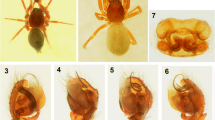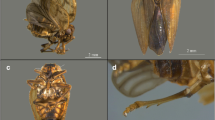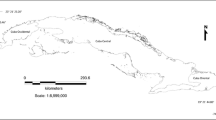Abstract
The monospecific fern genus Nephopteris has previously been collected in three subpáramos of Colombia, one in the Western Cordillera, and two in the Eastern Cordillera. Only five collections are available, the most recent having been made in 1973. The genus was thought to be extinct because the three subpáramos where it has been found have undergone strong anthropogenic disturbance during the last five decades. Recently, we rediscovered N. maxonii in the Central and Eastern Cordilleras. Here we report detailed observations of this poorly known genus, revise its original description, and provide the first in vivo photographs of the species. Of the anatomical traits here examined, the siphonostelic to dictyostelic rhizomes with hairs and the presence of paraphyses along the soral lines support the traditional placement of Nephopteris in the subfamily Taenitidoideae of the Pteridaceae. In addition, we propose that this taxon should be included as Critically Endangered (CR), following the IUCN Red List criteria, based on the small population size, the extreme geographical isolation of the known locations, the narrow elevational belt occupied by the species in cloud subpáramos in Colombia, and the increasing disturbance of this severely fragmented and fragile habitat.
Resumen
El género monoespecífico Nephopteris ha sido colectado hasta ahora en tres subpáramos de Colombia: uno en la Cordillera Occidental y dos en la Cordillera Oriental. Solo existen cinco colecciones, la última efectuada en 1973. Se pensaba que el género se había extinguido, debido a la destrucción del hábitat, en las últimas cinco décadas, de todos los subpáramos donde había sido recolectado. Recientemente, redescubrimos N. maxonii en las Cordilleras Central y Oriental. Aquí, se reportan observaciones detalladas de este género poco conocido, se revisa su descripción original, y se presentan las primeras fotografías in vivo de la especie. De los rasgos anatómicos examinados, la presencia de rizomas tricomatosos, sifonostélicos a dictiostélicos, y de paráfisis a lo largo de las líneas de soros sustentan la inclusión tradicional de Nephopteris en la subfamilia Taenitioideae de las Pteridaceae. Además, se propone que este taxón debe ser incluído en la categoría En Peligro Crítico (CR) de la Lista Roja de la UICN, teniendo en cuenta el reducido tamaño poblacional observado, el extremo aislamiento geográfico de las localidades conocidas, la estrecha franja altitudinal que ocupa en subpáramos nublados de Colombia, y la continua destrucción de este hábitat extremadamente frágil y fragmentado.




Similar content being viewed by others
Literature Cited
Archangelsky, S. & L. Villar de Seoane. 1998. Estudios palinológicos de la Formación Baqueró (Cretácico), Provincia de Santa Cruz, Argentina. VIII. Ameghiniana 35: 7–19.
Callejas-Posada, R. & A. Idárraga (eds.). 2011. Flora de Antioquia. Catálogo de las Plantas Vasculares. 2 vols. Universidad de Antioquia, Missouri Botanical Garden & Oficina de Planeación departamental de la Gobernación de Antioquia, Editorial D´Vinni, Bogotá.
Castaño-Uribe, C., L. Franco-Vidal & C. Rey. 2003. Colombia. Pp. 39–86. In: R. Hofstede, P. Segarra & P. Mena-Vásconez (eds.), Los páramos del Mundo. Proyecto Atlas Mundial de los páramos. Global Peatland Initiative/NC-IUCN/EcoCiencia. Quito.
Cochran, A.T., J. Prado & E. Schuettpelz. 2014. Tryonia, a new taenitidoid fern genus segregated from Jamesonia and Eriosorus (Pteridaceae). PhytoKeys 35: 23-43.
IUCN. (2012). IUCN Red List Categories and Criteria: Version 3.1. Second edition. Gland, Switzerland and Cambridge, UK: IUCN. iv +32 pp.
Johansen, D. A. 1940. Plant microtechnique. McGraw Hill, New York.
Kraus, J. E., H. C. De Souza, M. H. Rezende, N. M. Castro, C. Vecchi & R. Luque. 1998. Astra blue and basic fuchsin double staining of plant material. Biotechnic & Histochemistry 73: 235–243.
Lellinger, D. B. 1966. Nephopteris, a new genus of ferns from Colombia. American Fern Journal 56: 180–182.
Lozano-Contreras, G., N. Ruiz, F. González & M. T. Murillo-Pulido. 1996. Notas sobre biodiversidad. Biblioteca José Jerónimo Triana No. 13, Instituto de Ciencias Naturales, Universidad Nacional de Colombia.
Luteyn, J. L. 1999. Páramos. A checklist of plant diversity, geographical distribution, and botanical literature. Memoirs of the New York Botanical Garden 84: 1–278.
Murillo-Pulido, M. T & M. A. Harker-Useche. 1990. Helechos y plantas afines de Colombia. Academia Colombiana de Ciencias Exactas, Físicas y Naturales. Colección Jorge Alvarez Lleras No. 2. Bogotá. 323 pp.
——— & A. R. Smith. 2003. Luisma, a new genus of Grammitidaceae (Pteridophyta) from Colombia. Novon 13: 313–317.
———, J. Murillo-Aldana, A. León-Parra & L. A. Triana-Moreno. 2008. Los Pteridófitos de Colombia. Biblioteca José Jerónimo Triana No. 18. Instituto de Ciencias Naturales. Universidad Nacional de Colombia. Bogotá.
Nakazato, T. & G. Gastony. 2003. Molecular phylogenetics of Anogramma species and related genera (Pteridaceae: Taenitiodoideae). Systematic Botany 28: 490–502.
Ogura, Y. 1972. Comparative anatomy of vegetative organs of the Pteridophytes. Gebrüder Borntraeger, Berlin.
Sánchez-Baracaldo, P. 2004. Phylogenetic relationships of the subfamily Taenitioideae, Pteridaceae. American Fern Journal 94: 126–142.
Schuettpelz, E., H. Schneider, L. Huiet, M. D. Windham & K. M. Pryer. 2007. A molecular phylogeny of the fern family Pteridaceae: Assessing overall relationships and the affinities of previously unsampled genera. Molecular Phylogenetics and Evolution 44: 1172–1185.
Tryon, R. M. & A. F. Tryon. 1982. Ferns and allied plants, with special reference to tropical America. Springer-Verlag, Berlin.
———, A. F. Tryon & K. U. Kramer. 1990. Pteridaceae. Pp. 230–256. In: K. U. Kramer & P. S. Green (eds.), Pteridophytes and Gymnosperms. The Families and Genera of Vascular Plants. Springer-Verlag, Berlin.
Acknowledgments
We thank Vanessa Suaza-Gaviria (Universidad de Antioquia) for field assistance, Laura Michell Rojas (Universidad de Antioquia) for microscopy assistance, and Lucía Atehortúa (Universidad de Antioquia) for allowing us to use the microscopy facilities of the Biotechnology laboratory. Alejandra Vasco and Jefferson Prado provided helpful comments on the manuscript. This work was supported by the Convocatoria Programática Ciencias Exactas y Naturales 2012-2013 and by the Estrategia de Sostenibilidad 2013–2014 from the Committee for Research Development (CODI), Universidad de Antioquia (Medellín-Colombia).
Author information
Authors and Affiliations
Corresponding author
Rights and permissions
About this article
Cite this article
González, F., Callejas-Posada, R. & Pabón-Mora, N. Rediscovery and conservation status of the “cloud fern,” Nephopteris maxonii (Pteridaceae), with notes on its anatomical traits. Brittonia 67, 59–67 (2015). https://doi.org/10.1007/s12228-014-9359-8
Published:
Issue Date:
DOI: https://doi.org/10.1007/s12228-014-9359-8




